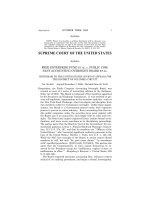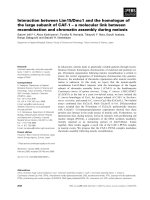Synopsis of Some Genera of the Large Pyrenomycetes doc
Bạn đang xem bản rút gọn của tài liệu. Xem và tải ngay bản đầy đủ của tài liệu tại đây (1.63 MB, 101 trang )
The Project
Gutenberg eBook,
Synopsis of Some
Genera of the
Large
Pyrenomycetes, by
C. G. Lloyd
This eBook is for the use of anyone
anywhere at no cost and with
almost no restrictions whatsoever. You may
copy it, give it away or
re-use it under the terms of the Project
Gutenberg License included
with this eBook or online at
www.gutenberg.org
Title: Synopsis of Some Genera of
the Large Pyrenomycetes
Camilla, Thamnomyces,
Engleromyces
Author: C. G. Lloyd
Release Date: June 7, 2007 [eBook
#21761]
Language: English
Character set encoding: ISO-8859-1
***START OF THE PROJECT
GUTENBERG EBOOK SYNOPSIS OF
SOME GENERA OF THE LARGE
PYRENOMYCETES***
E-text prepared by Victoria
Woosley, La Monte H. P.
Yarroll,
and the Project Gutenberg
Online Distributed
Proofreading Team
()
TRANSCRIBER'S NOTES:
1. Irregularities or errors in spelling,
punctuation or capitalization have
been preserved as in the original text.
2. The paragraphs immediately before
and after the heading "SECTION 2.
PHYLACIA." were printed in a
smaller font in the original. This did
not seem justified from the context,
so the sections have been displayed
in normal text. Other places where
the original used a smaller font have
been displayed in a smaller font in
this version.
SYNOPSIS
OF
SOME GENERA
OF THE
LARGE
PYRENOMYCETES
CAMILLEA
THAMNOMYCES
ENGLEROMYCES
By
C. G. LLOYD
CINCINNATI, OHIO,
JANUARY, 1917
THE GENUS
CAMILLEA.
The receipt of a nice specimen of
Camillea Cyclops from Rev. Torrend,
Brazil, has induced us to work over the
similar species in our collection. On our
last visit to Europe we photographed the
various specimens we found in the
museums, but did not study them as to
structure. However, they make such
characteristic photographs that we believe
the known species can be determined from
our figures.
We are all familiar with the common
Hypoxylons that form little globose, black
balls, usually on dead limbs, in our own
woods. They have a solid carbonous
interior with the perithecia imbedded near
the surface. There have been over two
hundred alleged Hypoxylons, mostly from
the tropics. We have never worked them
over, but suspect that a number of them
from the tropics, when examined, will be
found to be Camilleas. If the specimens
were examined, no doubt "prior" specific
names would be found for several of this
list.
1
In the old days all similar carbonous
fungi were called Sphaeria. Montagne
first received a section of Sphaeria with
cylindrical form, from South America.
The perithecia were long, cylindrical, and
were arranged in a circle or were
contiguous, near the summit of the stroma.
He proposed to call it Bacillaria, as a
section of Sphaeria, but the name being
preoccupied, he, at the suggestion of
Fries, afterwards named it in honor of
himself, Camillea, Montagne's first name
being Camille.
The original species were separated
into a genus by Montagne in 1855, and
five species listed, and it is a curious fact
that these five species, as well as all
others that have since been added, are of
the American tropics. I have not worked
over the "Hypoxylons" in the museums,
but as far as the records go the genus
Camillea does not occur in other tropical
countries.
In 1845 Léveillé announced that he
had discovered a plant resembling an
Hypoxylon which had, however, the
spores borne on filaments (acrogenous),
and not in perithecia. He called it
Phylacia globosa, and classified it in
Sphaerioidaea. The specimen (Fig. 847)
is still at Paris. Saccardo has omitted it,
and states that Phylacia is probably a
pycnidial condition of Hypoxylon
turbinatum. Both were guesses, one
statement surely, and both probably,
wrong. The interior is filled with a
powder that under the microscope appears
to be made up of ligneous filaments mixed
with a few spores. These filaments appear
to me to be the disintegrated walls of the
perithecia, and not the "filaments that bear
the spores." From analogy, at any rate, the
spores of all these similar species are
probably borne in asci which disappear
early, and Phylacia seems to be the same
genus as Camillea, the walls of the
perlthecla disintegrating and forming a
powdery mass. If this view is correct,
Camillea can be divided into two
sections.
EUCAMILLEA.—Perithecia
persistent.
PHYLACIA.—Perithecia early
disintegrated.
SECTION 1. EUCAMILLEA.
826.
CAMILLEA LEPRIEURII (Fig. 826).
—Carbonous, black, cylindrical, 2-3 cm.
long, 3-4 mm. thick. Apex truncate,
excavate. Perithecia linear, near apex of
stroma. Asci (teste Montagne) linear, 8
spored. Spores (pale) spindle shape, dark,
6-7 × 25-35 mic.
A most peculiar and apparently a
rare species. All the specimens I have
noted came to Montagne from Leprieur,
French Guiana. Berkeley records it from
Brazil, Spruce, but I think it has not been
collected in recent years. Our figure 826
is from specimens in Montagne's
herbarium, and these are three times as
long as the specimen Montagne pictures. I
saw no such short specimens. Patouillard
has given a detailed account of the
structure of the plant. The perithecia are
arranged in a circle neat the apex of the
stroma. The spores are spindle shaped
(rather than caudate, as Montagne shows
them) and 25 to 35 mic long. Patouillard
claims that Hypoxylon melanaspis has
same spores and structure, and is the
pulvinate form of Camillea Leprieurii. It
does not seem possible to me, but I can
Fig. 827.
not say to the contrary.
CAMILLEA BACILLUM (Fig. 827).
—Stroma cylindrical, black, 1 cm. long, 1
mm. thick. Apex truncate, shown
punctulate in Montagne's drawing. Spores
dark, reniform.
This is
very similar to
the preceding
in shape, but
is a much
smaller
species with
different
spores (teste
Montagne).
We have only
seen the originals in Montagne's
herbarium, from which our figure is made.
The drawing given by Montagne
represents the plant better than our
photograph. Montagne records the species
from Cuba and French Guiana. We think it
a very rare plant.
CAMILLEA MUCRONATA (Fig.
828).—Stroma cylindrical, black, 6 mm.
long, 3 mm. thick. Apex with a prominent,
mucronate point. Perithecia linear,
contiguous, near the apex of the plant.
Asci cylindrical. Spores oblong (M.) 3½
to 4 × 10 mic., colored.
Fig. 828.
This also is a rare species, only
known from the original collection by
Leprieur, French Guiana. Our photograph
is from the type. In the original drawing
there is a circle of little acute
protuberances shown near the apex of the
plant. We can see but faint indication of
them in our photograph.
CAMILLEA LABELLUM (Fig. 829).
—Plant short, cylindrical, about a cm. tall
and thick, with a depressed disc.
Perithecia contiguous, forming at layer
beneath the disc. Spores (M.) fusiform,
dark, 30 mic., long.
I believe the plant is only known
from the original collection in Montagne's
herbarium, from Leprieur, French Guiana.
It does not follow, however, that it is such
a rare plant, but only that the plants of the
region have been scantily collected. Our
figure is a photograph of the types.
Fig. 829.
CAMILLEA TURBINATA (Figs.
830-833).—Plants obconic or turbinate,
about a cm. tall and broad, growing in a
dense cluster from a common, mycelial
carbonous base. The summit is truncate,
and marked with a raised central disc,
which is thin and in old plants breaks
irregularly. A section of a young plant
(Figs. 831 ×6) shows the lower part
composed of rather soft, carbonous tissue,
the upper filled with a light brown
powder, composed of spores mixed with
hyphae tissue. In old plants the tops break
in, the powder is dissipated, and there
remains (Fig. 833) a bundle of carbonous
tubes, the walls of the perithecia. Finally,
these break up and disappear, leaving the
upper part of the plant hollow. The spores
are elliptical, 6-7 × 16-18 mic., smooth,
light colored. The asci which disappear at
at very early stage, are shown by Moeller
as oval, each containing 8 spores.
This is at common plant in our
American tropics, and was named by
Berkeley, as Hypoxylon turbinatum, but in
a later paper he referred it to Camillea
turbinata. It is compiled in Saccardo as
Hypoxylon. I doubt not but that it was
named Sphaeria caelata by Fries many
years "prior." Spegazzini found it
abundantly, and noting that it was not a
good Hypoxylon, puzzled over it in two or
three papers and finally also concluded
that it was at Camillea. Moeller also
"discovered" it, and although the common
plant was well known in other centers, the
rumors had not reached Berlin, hence he
"discovered" it was a new genus, which
he dedicated to his friend, Dr. Hennings
and called it Henningsinia durissima.
Fortunately, he gave a good figure by
which his "discovery" could be
interpreted.
We have beautiful specimens from
Dr. J. Dutra, Brazil, from which our figure
was made, also we have specimens from
Rev. Rick.
Fig. 830. Camillea turbinata. (Side view, natural
size.)









